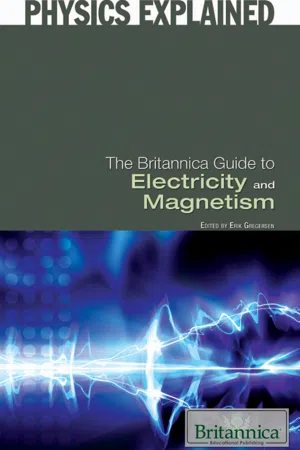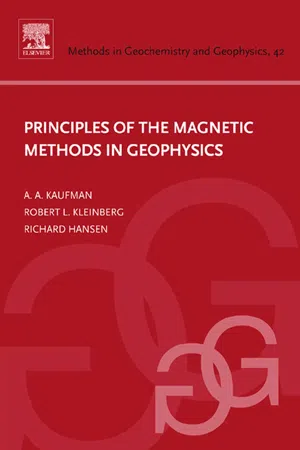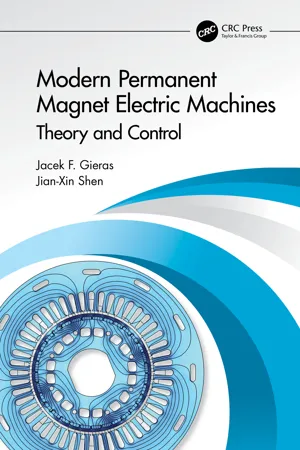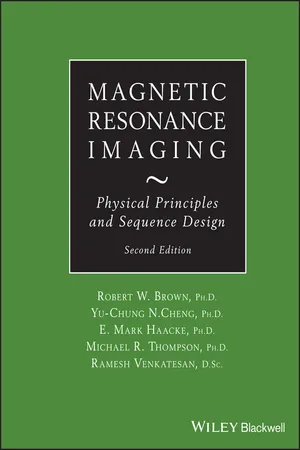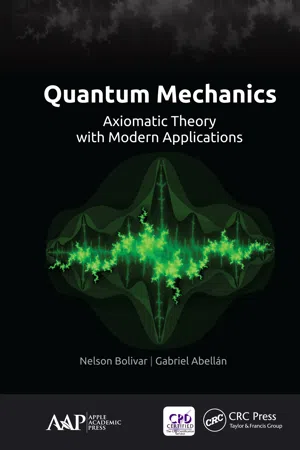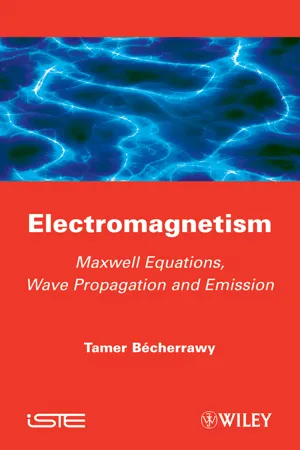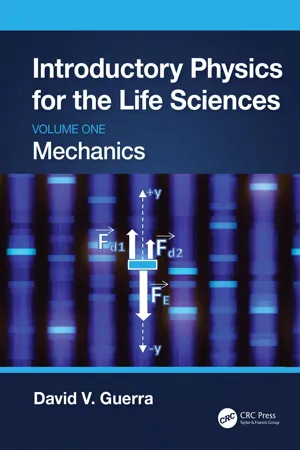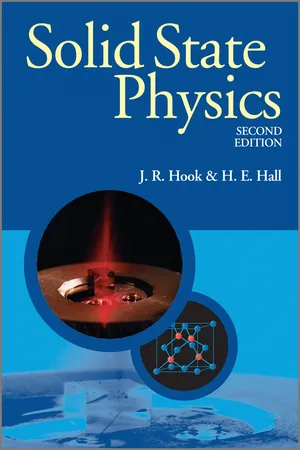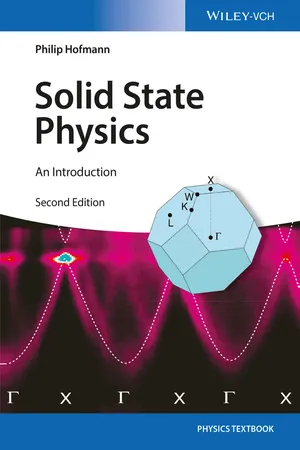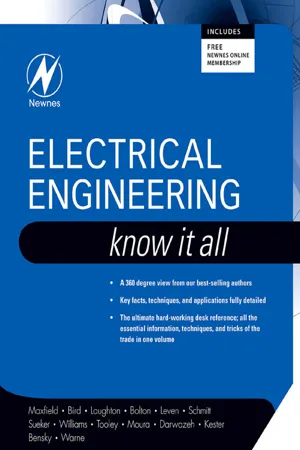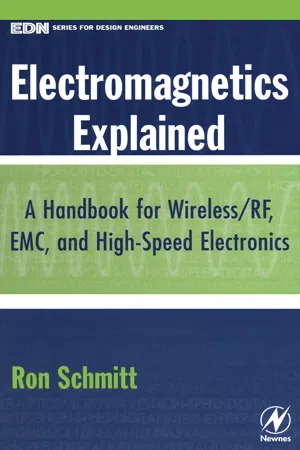Physics
Magnetic Moment
Magnetic moment refers to the property of a magnet or current-carrying loop that gives rise to a magnetic field. It is a measure of the strength and orientation of the magnetism in a material. The magnetic moment is a vector quantity, with both magnitude and direction, and is fundamental to understanding the behavior of magnetic materials.
Written by Perlego with AI-assistance
Related key terms
Related key terms
1 of 4
Related key terms
1 of 3
12 Key excerpts on "Magnetic Moment"
- Britannica Educational Publishing, Erik Gregersen(Authors)
- 2010(Publication Date)
- Britannica Educational Publishing(Publisher)
The magnetic dipole moment may be thought of as a measure of a dipole’s ability to turn itself into alignment with a given external magnetic field. In a uniform magnetic field, the magnitude of the dipole moment is proportional to the maximum amount of torque on the dipole, which occurs when the dipole is at right angles to the magnetic field. The magnetic dipole moment, often simply called the Magnetic Moment, may be defined then as the maximum amount of torque caused by magnetic force on a dipole that arises per unit value of surrounding magnetic field in vacuum.Magnetic dipole moments have dimensions of current times area or energy divided by magnetic flux density. In the metre–kilogram–second–ampere and SI systems, the specific unit for dipole moment is ampere-square metre. In the centimetre–gram–second electromagnetic system, the unit is the erg (unit of energy) per gauss (unit of magnetic flux density). One thousand ergs per gauss equal one ampere-square metre. A convenient unit for the magnetic dipole moment of electrons is the Bohr magneton (equivalent to 9.273 × 10−24 ampere–square metre). A similar unit for Magnetic Moments of nuclei, protons, and neutrons is the nuclear magneton (equivalent to 5.051 × 10−27 ampere-square metre).All matter exhibits magnetic properties to some degree. When placed in an inhomogeneous field, matter is either attracted or repelled in the direction of the gradient of the field. This property is described by the magnetic susceptibility of the matter and depends on the degree of magnetization of the matter in the field. Magnetization depends on the size of the dipole moments of the atoms in a substance and the degree to which the dipole moments are aligned with respect to each other. Certain materials, such as iron, exhibit very strong magnetic properties because of the alignment of the Magnetic Moments of their atoms within certain small regions called domains. Under normal conditions, the various domains have fields that cancel, but they can be aligned with each other to produce extremely large magnetic fields. Various alloys, such as NdFeB (an alloy of neodymium, iron, and boron), keep their domains aligned and are used to make permanent magnets. The strong magnetic field produced by a typical threemillimetre-thick magnet of this material is comparable to an electromagnet made of a copper loop carrying a current of several thousand amperes. In comparison, the current in a typical light bulb is 0.5 ampere. Since aligning the domains of a material produces a magnet, disorganizing the orderly alignment destroys the magnetic properties of the material. Thermal agitation that results from heating a magnet to a high temperature destroys its magnetic properties.- eBook - ePub
- (Author)
- 2008(Publication Date)
- Elsevier Science(Publisher)
The Feynman's Lectures on Physics ”, we start to describe some features of magnetic materials as well as some methods of measuring the magnetic field based on a behavior of electrons and nucleus of atoms.6.2 The angular momentum and Magnetic Moment of an atom
At the beginning consider the simplest model of a single atom in the absence of an external magnetic field when there is only one electron rotating around a nucleus in the plane perpendicular to the z -axis (Fig. 6.1(a) ). First, we focus on this orbital motion. In accordance with the classical mechanics, let us assume that the radius of its orbit is r . By definition, a motion of an electron represents a current I along the orbit and, correspondingly, this small loop can be treated as the magnetic dipole with the moment p directed along the z -axis:Fig. 6.1 (a) Relation between Magnetic Moment and angular momentum. (b) Precession of the magnetic dipole.(6.1)Here z 0 is a unit vector directed along the z -axis and a direction of this vector and that of the electron velocity obeys the right-hand rule. Inasmuch as the current is amount of a charge passing through any point of the orbit per unit time, we have(6.2)where q is the electron charge and T the period of its rotation. Introducing the linear velocity of the electron v , we haveand therefore the current can be represented as Thus, the Magnetic Moment of the dipole is(6.3)and it is directly proportional to the negative charge q , its velocity, and a radius of the orbit. It is clear that this tiny current system creates its own magnetic field which is extremely small. The second parameter of an orbital motion of an electron is its angular momentum, L - eBook - ePub
Modern Permanent Magnet Electric Machines
Theory and Control
- Jacek F. Gieras, Jian-Xin Shen(Authors)
- 2022(Publication Date)
- CRC Press(Publisher)
It means that the elementary magnetic source is the dipole formed by the loop of current. Fig. 1.3 shows alignment of atomic dipole moments. Particles with spin can possess a magnetic dipole moment, just like a rotating electrically charged body in classical electrodynamics. Fig. 1.4. Alignment of magnetic dipole moments in: (a) ferromagnetic materials such as iron, nickel, cobalt; (b) most materials. Fig. 1.5. The dipole is formed by the loop of current: (a) orbital magnetic dipole; (b) magnetic field lines above electron. The electric current I = e T = e v 2 π R A (1.2) where the charge of electron (elementary charge) e = 1.60217662 × 10 − 19 C, T is the time of one revolution, the surface of the orbit S = π R 2 and the linear speed v = R Ω, and the angular speed Ω = 2 π n, the rotational speed is n. The magnetic dipole moment of one atom expressed as a scalar m = I S = e v 2 π R π R 2 = 1 2 e v R = 1 2 e Ω R 2 Am 2 (1.3) The mass of the electron is m e = 9.10938356 × 10 − 31 kg. An orbiting electron is equivalent to the magnetic dipole moment. For N dipoles m → = n → N I S Am 2 (1.4) 1.2 Magnetic permeability, magnetization vector, magnetic susceptibility Magnetic permeability is the measure of the ability of a material to support the formation of a magnetic field within itself. The magnetic permeability of free space, also known as the magnetic constant is μ 0 = 0.4 π × 10 − 6 H/m (1.5) On 20 May 2019, a revision to the SI system went into effect, making the vacuum permeability no longer a constant but rather a value that needs to be determined experimentally. For comparison, the electric permittivity, also known as the electric constant is ϵ 0 = 1 36 π × 10 − 9 F/m (1.6) The volume magnetic susceptibility χ is a dimensionless quantity defined by the following relationship M → = χ H → A/m (1.7) where M → is the magnetization of the material (the magnetic dipole moment per unit volume) [A/m] and H → is the magnetic field strength vector [A/m] - eBook - ePub
Magnetic Resonance Imaging
Physical Principles and Sequence Design
- Robert W. Brown, Y.-C. Norman Cheng, E. Mark Haacke, Michael R. Thompson, Ramesh Venkatesan(Authors)
- 2014(Publication Date)
- Wiley-Blackwell(Publisher)
Ch. 5 we will show how to derive the principal results of this chapter in the more fundamental quantum mechanical framework.2.1 Magnetic Moment in the Presence of a Magnetic Field
In this section, we briefly review the magnetic force, Magnetic Moment given by a current loop, torque due to the force, and its relation to the Magnetic Moment and field. We also provide another example of the torque for a magnetic dipole in an external field. The torque is related to the change of angular momentum as discussed in Sec. 2.2 where it serves as a building block of the Bloch equation.2.1.1 Torque on a Current Loop in a Magnetic Field
We begin with a study of magnetic forces on current-carrying conductors, in order to introduce the interaction of a proton with an external magnetic field. A circular loop of current I and area A is pictured with two different orientations in Fig. 2.1 . If an external magnetic field is turned on, the loop will feel a differential force on each of its differential segments given by the basic Lorentz force law (see Appendix A),Fig. 2.1 : Circular current loop depicted in two different orientations relative to a uniform magnetic field. The forces on representative differential current segments are shown (one explicitly shown in each case). The first (a) shows the current plane perpendicular to the field where there is no net twist (torque); the second (b) shows the current plane at an arbitrary angle to the field where there is a nonzero torque.(2.1 )This cross product implies that the differential force is perpendicular to the plane defined by two vectors: the current segment and the magnetic field evaluated at that segment. It is in the direction that a right-hand screw, perpendicular to the plane, advances when rotated from the current segment vector to the magnetic field vector.The total force on the circular loop, and indeed on any closed loop, due to a uniform (constant over space) external magnetic field is zero. As an example, the symmetrical vector sum of the differential forces on either current loop in Fig. 2.1 clearly vanishes for any loop orientation. To prove it in general, the result follows from an integral over (2.1 ), where I and can be taken outside the integral, since for an integration around any closed path. Now zero total force means zero change in the total momentum - eBook - ePub
- B. D. Cullity, C. D. Graham(Authors)
- 2011(Publication Date)
- Wiley-IEEE Press(Publisher)
spin of the electron was postulated in 1925 in order to explain certain features of the optical spectra of hot gases, particularly gases subjected to a magnetic field (Zeeman effect), and it later found theoretical confirmation in wave mechanics. Spin is a universal property of electrons in all states of matter at all temperatures. The electron behaves as if it were in some sense spinning about its own axis, and associated with this spin are definite amounts of Magnetic Moment and angular momentum. It is found experimentally and theoretically that the Magnetic Moment due to electron spin is equal to(3.5)Fig. 3.1Visualization of electron spin.Thus the Magnetic Moment due to spin and that due to motion in the first Bohr orbit are exactly equal. Because it is such a fundamental quantity, this amount of Magnetic Moment is given a special symbol μB and a special name, the Bohr magneton . Thus,(3.6)It is a natural unit of Magnetic Moment, just as the electronic charge e is a natural unit of electric charge.How can the Magnetic Moment due to spin be understood physically? We may, if we like, imagine an electron as a sphere with its charge distributed over its surface. Rotation of this charge produces an array of tiny current loops (Fig. 3.1 ), each of which has a Magnetic Moment directed along the rotation axis. But if we calculate the resultant moment of all these loops, we obtain the wrong answer, (5/6)μB instead of μB . Nor does the right answer result from the assumption that the charge is uniformly distributed through the volume of the sphere. Such calculations are fruitless, because we do not know the shape of the electron or the way in which charge is distributed on or in it. The spin of the electron, and its associated Magnetic Moment, has to be accepted as a fact, consistent with wave mechanics and with a large number of experiments of various kinds, but with no basis in classical physics. The model of Fig. 3.1 is therefore only an aid to visualization; it has no quantitative significance.3.3 Magnetic MomentS OF ATOMSAtoms contain many electrons, each spinning about its own axis and moving in its own orbit. The Magnetic Moment associated with each kind of motion is a vector quantity, parallel to the axis of spin and normal to the plane of the orbit, respectively. The Magnetic Moment of the atom is the vector sum of all its electronic moments, and two possibilities arise:1. The Magnetic Moments of all the electrons are so oriented that they cancel one another out, and the atom as a whole has no net Magnetic Moment. This condition leads to diamagnetism. - eBook - ePub
Quantum Mechanics
Axiomatic Theory with Modern Applications
- Nelson Bolivar, Gabriel Abellán(Authors)
- 2018(Publication Date)
- Apple Academic Press(Publisher)
z component of the associated Magnetic Moment is expected to be,(11.2)S z=m sħ , withm s= ±1 2,as the Magnetic Moment associated with the orbital component of the angular moment, but experimentally have the values, where e and mis predicted by quantum mechanics in the Dirac equation [114]. From this comes a natural constant called Bohr Magneton, defined as,eare charge and mass of the electron respectively, and g is called the gyromagnetic constant: for the electron this is g = 2.00232. The exact value of g(11.3)The spin Magnetic Moment is important in spin‐orbit interactions and interactions between atoms and an external magnetic fields.μ z= ±1 2e ħ2m eThe term spin should not be taken literally, that is, in the classical sense of a rotating sphere on itself. A rotating sphere around its axis produces a Magnetic Moment, but the intensity of this must be reasonable in relation to the size of the sphere itself. High energy diffusion experiments show that the electron does not have “body” up to a resolution of 10−3 fermi: at these levels, to produce the observed Magnetic Moment, a rotation of about 1032 rad /s is needed, too excessive even for atomic world.11.1.1 Importance of Spin
There are four important reasons to introduce spin. First, the connection between spin and magnetism, necessary for storing information. The spin is connected to ferromagnetic materials because spontaneous magnetization allows the electronic states to become spin‐dependent, while for nonmagnetic materials the electronic states come in pairs with the same energy but with opposite spin, which leads to a density states independent of spin. Basically, in a ferromagnetic material, the density of states is different for spin‐up and spin‐down. Since many transport properties depend on the density of states near the Fermi energy, asymmetry in the density of states allows ferromagnets to generate, manipulate, and reveal spin. In addition, ferromagnetic materials possess the property of hysteresis: if the ferromagnet is subject to a magnetic field, a history of a cycle in applying and removing the magnetic field remains, called hysteresis. - eBook - ePub
Electromagnetism
Maxwell Equations, Wave Propagation and Emission
- Tamer Becherrawy(Author)
- 2013(Publication Date)
- Wiley-ISTE(Publisher)
l is the local field.ΓM tends to orient in the direction of B l . However, the alignment cannot be complete because of the thermal agitation (Figure 7.2d ). If the medium is isotropic, the transverse component of (i.e. perpendicular to B l ), has the same probability to point in opposite directions; thus, the average Magnetic Moment < > is parallel to B l . We have seen that the induced mean Magnetic Moment in diamagnetic materials is also in the direction of B l . Thus, if the medium is linear and isotropic and the external field is not very strong, we may assume that the mean Magnetic Moment is proportional to B l (the terms of the order B l 2 or higher being negligible):[7.6]The atoms of all substances may acquire a small diamagnetic magnetization. The corresponding polarizability αM is negative and independent of the physical conditions. On the other hand, in the case of paramagnetic and ferromagnetic substances, the polarizability αM is positive, much higher than the diamagnetic polarizability, and it depends on physical conditions (especially temperature). Thus, diamagnetism is a general property of matter, while paramagnetism and ferromagnetism are properties of some specific materials that hide diamagnetism.If the correlation of the Magnetic Moments is weak, an element of volume d υ acquires a Magnetic Moment d υ N v < > where N v is the number of atoms or molecules per unit volume. Thus, the medium becomes magnetized with an intensity of magnetization (or simply a magnetization )[7.7 ]We expect that, in the case of paramagnetism, M increases with B l and increases if the temperature decreases (as the thermal agitation decreases). However, M reaches a saturation value M max = N v if all the Magnetic Moments point in the same direction; this occurs if B l - David V. Guerra(Author)
- 2023(Publication Date)
- CRC Press(Publisher)
N I), so the torque will be:τ = B N I AThe number of loops, the current, and the area of the loop are put together in equation (6.4) asμ = N I A(6.4)which is the Magnetic Moment, μ, of the loop. With this definition of the Magnetic Moment, the torque on a current loop is defined in equation (6.5) asτ = μ B sin(6.5)( θ )where θ is the angle between the direction of the magnetic field and the direction of the magnetic dipole, which is defined as perpendicular to the current loop and given by a RHR in which the fingers of your right hand and your thumb point in the direction of the magnetic dipole. For example, in Figure 6.17 , the magnetic dipole points to the page.Thus, in this figure, the angle between the magnetic field and the magnetic dipole is 90°, since the magnetic field is from left to right across the page and the magnetic dipole is into the page. As explained in the description of the forces on the individual lines of current in the loop and the resulting torque on the loop, the net result will be that the external magnetic field will tend to align the magnetic dipole of the loop with itself. This Magnetic Moment of a particle is the quantity that is assigned to the concept of particle spin.6.7 Answer to the Chapter Question
In an MRI, the large external magnet aligns the Magnetic Moments of the hydrogen nuclei in the patient’s body in the same or opposite direction as the magnetic field. The hydrogen nuclei begin to precess around the magnetic field lines, as described by the dashed line in Figure 6.18- eBook - ePub
- J. R. Hook, H. E. Hall(Authors)
- 2013(Publication Date)
- Wiley(Publisher)
πr : the minus sign indicates that the electron is moving in the opposite direction to the current. It is a principle of electromagnetism (Ampère’s law) that such a current loop has a magnetic dipole moment(7.3)where a is the ‘area’ vector of the loop, directed so that the current is in a clockwise sense when looking along a. Thus(7.4)where l is the angular momentum vector of the orbiting electron (| l| = mνr ) and we have used |a| = πr 2 . We write the angular momentum as l since is the natural unit for the orbital angular momentum of atoms. It thus follows from Eq. (7.4) that the natural unit for the Magnetic Moment is the Bohr magneton μ B , where(7.5)Eq. (7.4) indicates that there will be a contribution to the Magnetic Moment of an atom from the orbital angular momentum of the electrons within it. Eq. (7.4) remains valid in a quantum mechanical treatment provided that 1 is regarded as the angular momentum operator of the electron.There is also a Magnetic Moment,(7.6)associated with the intrinsic (spin) angular momentum s of the electron; to a very good approximation (certainly good enough for our purposes) g 0 = 2.Fig. 7.1 An electron in a circular orbit is equivalent to a current loop and hence to a Magnetic MomentComparison of Eqs. (7.4) and (7.6) then shows that spin angular momentum is twice as effective in generating Magnetic Moment as orbital angular momentum. The eigenvalues of the z component,sz, of s are ± so that, from Eq. (7.6) , the z component of the intrinsic Magnetic Moment can take the values ± μ B .The total magnetic dipole moment of the atom is obtained by summing Eqs. (7.4) and (7.6) - eBook - ePub
Solid State Physics
An Introduction
- Philip Hofmann(Author)
- 2015(Publication Date)
- Wiley-VCH(Publisher)
(c) Possible orientations for the Magnetic Moment in field direction for). The Magnetic Moment of an atom is caused by the orbital and spin angular momenta. In a hydrogen atom, the orbital angular momentum L of the single electron (measured in units of) is accompanied by a Magnetic Moment with 8.15 This Magnetic Moment precesses around the direction of an applied field as shown in Figure 8.1 a. The component of the Magnetic Moment in the direction of the field is quantized and given by the magnetic quantum number : 8.16 If the orbital quantum number is l, then takes the values This is illustrated for in Figure 8.1 b. The situation for the spin S (also measured in units of) is very similar. It also leads to a Magnetic Moment 8.17 and possible Magnetic Moments in the field direction of 8.18 as already discussed in the previous section. Since, this means that. The hydrogen atom in the ground state has and and, therefore, only the spin Magnetic Moment matters. What about the more complex atoms with many electrons and an interaction between spin and orbital Magnetic Moments? This problem is greatly simplified by the observation that for a filled shell, that is, for a set of n,l, which is completely occupied, the total orbital Magnetic Moment is zero because the components in field direction and opposite to the field direction are equally strong. The same is true for the total spin Magnetic Moment because there are equally many electrons with spin and spin. So, we only have to worry about nonfilled shells. For these, we proceed in two steps. First, we have to find the total angular momentum that is described by the quantum number J. Then, we have to calculate the Magnetic Moment associated with J - eBook - ePub
- Clive Maxfield, John Bird, Tim Williams, Walt Kester, Dan Bensky(Authors)
- 2011(Publication Date)
- Newnes(Publisher)
Figure 21.16 . As you can see, its main characteristic is that it points in a direction parallel to the current, and it decays in magnitude as the distance to the current increases.Figure 21.16 A plot of the magnetic vector potential surrounding a current-carrying wireThe magnetic vector potential is much harder to understand than voltage, the electric potential. However, I will sketch out some of its characteristics. The magnetic field stores energy just as the electric field stores energy. In some situations the vector potential can be interpreted as the potential momentum of a charge. In fact, the units of the vector potential are those of momentum per charge. When Maxwell developed his theory of electromagnetism, he called the vector magnetic potential the electrodynamic momentum because it can be used to calculate the total momentum or total kinetic energy of a system of charged particles and their electromagnetic fields.21.5 Magnetic Materials
21.5.1 Diamagnetism
In Chapter 20 , you learned that different materials behave differently in electric fields. You learned about conductors and dielectrics. Electric fields induce reactions in materials. In conductors, charges separate and nullify the field within the conductor. In dielectrics, atoms or molecules rotate or polarize to reduce the field. Magnetic fields also induce reactions in materials. However, since there are no magnet charges, there is no such thing as a “magnetic conductor.” All materials react to magnetic fields similarly to the way dielectrics react to electric fields. To be precise, magnetic materials usually interact with an external magnetic field via dipole rotations at the atomic level. For a simple explanation, you can think of an atom as a dense positive nucleus with light electrons orbiting the nucleus, an arrangement reminiscent of the planets orbiting the sun in the solar system. Another similar situation is that of a person swinging a ball at the end of a string. In each situation, the object is held in orbit by a force that points toward the orbit center. This type of force is called a centripetal force. The force is conveyed by electricity, gravity, or the string tension, respectively, for the three situations. Referring to Figure 21.17 and using the cross product right hand rule, you find that the force due to the external magnetic field points inward, adding to the centripetal force. The increase in speed increases the electron’s magnetic field, which is opposite to the external field. The net effect is that the orbiting electron tends to cancel part of the external field. Just as the free electron rotates in opposition to a magnetic field, the orbiting electron changes to oppose the magnetic field. This effect is called diamagnetism - eBook - ePub
Electromagnetics Explained
A Handbook for Wireless/ RF, EMC, and High-Speed Electronics
- Ron Schmitt(Author)
- 2002(Publication Date)
- Newnes(Publisher)
spin ) and it certainly has charge. Although we don’t know what an electron is or what really happens inside an electron, we can think of an electron as a spinning ball of charge that creates its own magnetic dipole, just like the rotating currents inside the Earth create its magnetic field. The magnetic dipole of an electron is quite small and we typically can ignore it when we study the movement of a free electron. However, the electron’s magnetic field does play an important role when the electron is bound in the atomic structure of materials.EFFECTS OF THE MAGNETIC FIELD
The Dipole
Now that you understand how magnetic fields are created, you need to understand how magnetic objects are affected by an external magnetic field. The situation is more complex than the electric field, where charges just follow the electric field lines. The effect of the magnetic field is rotational. To analyze how the magnetic field operates, you need some form of fundamental test particle. For the electric field, we use a point charge (i.e., a charged, infinitesimally small particle). Since magnetic charges do not exist, some alternative must be used. One such test particle is an infinitesimally small magnetic dipole. A magnetic dipole test particle can be thought of as a compass needle made exceedingly small.A magnetic dipole has a north pole and a south pole, implying that it has direction in addition to magnitude. In other words, it is a vector quantity. The property of direction highlights a fundamental characteristic of the magnetic field that makes it different from the electric field. You know from experience that a compass needle always rotates so that the marked end (north pole) of the needle points north. If we place our conceptual compass in a magnetic field, the needle will likewise rotate until it points along the field lines. Its orientation will be such that its field lines up with those lines of the field in which it is immersed. So instead of a force being transmitted to the test dipole, torque is transmitted. A torque is the rotational analogy to a force. In this instance, the magnetic field acts as a “torque field” in comparison to the electric force field. This relation can be mathematically expressed as the following cross product:
Index pages curate the most relevant extracts from our library of academic textbooks. They’ve been created using an in-house natural language model (NLM), each adding context and meaning to key research topics.
Explore more topic indexes
Explore more topic indexes
1 of 6
Explore more topic indexes
1 of 4
